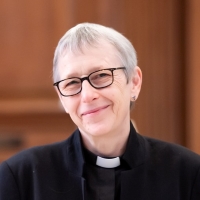Near to the parish where I served my curacy many years ago, deep in the heart of rural south Oxfordshire, there is a little village called Easington, comprising a few farm cottagers, a tiny church, and not very much else. And certainly when I knew it, thirty years ago, the place was so remote that Easington church had never had electricity installed.
One dark December afternoon, I can remember attending a funeral service in that little church – a service that was held entirely by candlelight. It was for me an unexpectedly strange and moving experience. It felt as if time had stood completely still over the centuries, as we gathered there in the flickering candlelight, just as the villagers of Easington had done since mediaeval times. I had a very acute sense that the boundary that separates past from present, the living from the dead, was, just for a moment, unusually thin.
Candlelight has a remarkable capacity to create atmosphere; so it should perhaps come as little surprise that, since earliest times, for symbolic as well as practical reasons, candles have been integral to Christian worship.
Candlelight is wonderfully and powerfully evocative. Because candles bring light into darkness. The most significant moment of the Christian year takes place at dawn on Easter Day, when we kindle the Easter flame, and bless and light a new Paschal candle, as a sign of the new life and new hope of the Risen Christ. A Christ who has triumphed over death.
But there is also something about the distinctive quality of candlelight that makes it particularly special. Because candlelight has a life of its own: it houses a living flame; a flame that moves and breathes; it flickers. It is also fragile, responding to the merest hint of movement in the air, and it is all too easily extinguished – and yet it also has to be treated with the greatest respect. Because a candle flame can also scorch and burn. I can remember some very wise words that were said to me by an experienced priest when I was first training for ministry. He said this: ‘Hands that handle sacred flame – the sacred flame of people’s pain, and suffering and loss, can become calloused and hard – which is why you must always enter that place with respect, and compassion, and gentleness.’
Candles are also, of course, traditionally associated with prayer: the heat and smoke as it rises upwards symbolising our prayers rising on their journey into the presence of God. And candles also weep, as the wax from a burning candle rolls down like tears.
Candlelight is beautiful, delicate, and alive. It is charged with presence and with meaning. It can bring us in touch with the transcendent; with things that are beyond our comprehension and our reach; it can bring us in touch with God.
The tradition of lighting candles for those whom we love, both the living and the dead, goes back centuries, and transcends all religious divides.
Many years ago, I visited Yad Vashem, the Holocaust Museum in Jerusalem, and went into the Children’s Memorial. The building that houses this particular memorial is subterranean: you descend a slope to enter it, and soon find yourself in almost total darkness, as one by one, you file down the corridor at the entrance, guided by a handrail. This passage suddenly opens out into a little hall ablaze with the flickering lights of literally millions of candles. The effect is quite simply breath-taking.
I discovered afterwards that I had in fact entered a chamber of mirrors and, remarkably, the astonishing effect of that countless number of flickering lights was created by a mere five candles, reflected an infinite number of times. As you pass through the chamber a recorded voice reads aloud the name of every single one of the children known to have perished during the Holocaust, together with their age, and the place of their death. There are so many names that it is said to take two years for the entire sequence of them to be read aloud.
But despite the unspeakable horror and tragedy of what was commemorated there, I was struck by something else as well. Because the place was also unimaginably beautiful, and in the strangest and most paradoxical of ways it felt … the word I am reaching for is hopeful. Because despite the tragic loss of each one of the those little lives, one knew that they were not forgotten. And that somehow, amidst the flickering light of all those millions of candle flames, one had a very real sense that somewhere, somehow, their lights still shine. Their story is not over; they are still there, held safe in the arms of the God who gave them life.
And I find that I glimpse something not dissimilar from that each year at this, our All Souls’ service. In a few moments time, here in church, I shall be reading the names of those whose funerals and memorial services we have taken this year, and others whom we have been asked to remember and commemorate. And every time that I do so, I am struck by the uniqueness of every individual whom we shall be naming before God this evening. Every name represents a very different story, of a different life, and indeed, a different death.
There are those who have died recently, the pain of whose loss is still acute; and those who died many years ago, but whose memories we still treasure. There are those who lived long and fulfilled lives – and those whose lives were, for one reason or another, cut tragically short. There are the names of children, including those who were stillborn, or lost before birth. There are churchgoers and non-churchgoers; there are Jews alongside Christians. All are included. All are commemorated. All are remembered with love.
As the candles are lit on the altar, and we see them flickering away, they are distant from us – symbolically just out of reach. And yet, each one of those moving flames speaks to us of a soul that is still very much alive, held safely in the arms of a loving God.
And the day will come when we shall be reunited with those whom we have loved, who have travelled the path through death’s dark vale before us. Because, as Christ showed us definitively – not through words, but through his life and death and resurrection, at the end of it all, love is quite simply far, far stronger than death.
And as we reflect on those flickering candles, we are reminded, too, of the communion of saints. Because however lonely the path to death may seem for the one who travels it, those who have died are no longer alone; they are part of the saints in light.
And it is also true, that however lonely the path of bereavement can feel – we do not travel that journey alone either – if you need proof of that – just remember those who are gathered here in church this evening. We have all been there.
I shall leave you with some words by the priest and poet John O’Donohue, who describes the process of grief in ways that some of you may already be able to recognise. He writes this:
Gradually, you will learn acquaintance
with the invisible form of your departed;
and when the work of grief is done
the wound of loss will heal
and you will have learned
to wean your eyes
from that gap in the air
and be able to enter the hearth in your soul
where your loved one has awaited your return all the time.
Amen.



